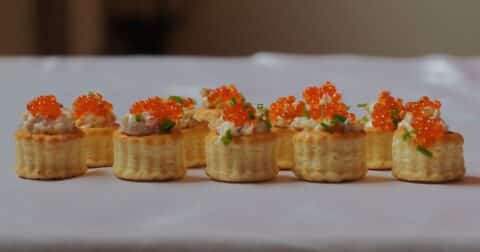Solutions
Chipotle’s Founder Is Betting on Plant-Forward Food
Food•2 min read
Investigation
A new investigation reveals fish cut open while still conscious.


Words by Jessica Scott-Reid
Caviar has long been synonymous with luxury and wealth — just one ounce can easily set you back hundreds of dollars. But in recent decades, these tiny bites of dark and salty opulence have come with a different cost. Overfishing has decimated wild sturgeon populations, forcing the industry to change tactics. Caviar has definitely managed to stay a booming business. But investors have shifted from extensive fishing operations to boutique caviar farms, now marketed to consumers as the sustainable option. Now, an investigation has documented conditions on one such organic caviar farm, finding the way fish are kept there may violate organic animal welfare standards.
Most caviar produced in North America today comes from fish farms, otherwise known as aquaculture. One reason for this is a 2005 U.S. ban on the popular beluga caviar variety, a policy put in place to curb the decline of this endangered sturgeon. By 2022, the U.S. Fish and Wildlife Service proposed to extend Endangered Species Act protections to four additional Eurasian sturgeon species, including the Russian, Persian, ship and stellate sturgeon. Once abundant, these species have plummeted by more than 80 percent since the 1960s, largely thanks to the kind of intensive fishing necessary to satisfy demand for caviar.
The demand for fish eggs has never let up. But since the early 2000’s, caviar farms have emerged as a sustainable alternative, with California boasting 80 to 90 percent of the farmed caviar market today. Just up the coast in British Columbia sits Northern Divine Aquafarms — North America’s first and only certified organic caviar farm, and Canada’s only producer of farmed white sturgeon.
Northern Divine Aquafarms says it farms over 6,000 “caviar ready” white sturgeon as well as tens of thousands more in its nursery. The operation also raises salmon for their eggs, otherwise known as roe. According to Canadian regulations, the organic certification requires the aquaculture operation to “maximize the welfare and minimize the stress on livestock.” And yet, undercover footage obtained from the BC facility last November shows fish treated in ways that could violate the organic standard.
Footage from the on-land farm, gathered by a whistleblower and made public by animal law organization Animal Justice, shows workers repeatedly stabbing fish in their abdomens, likely so they can determine whether the eggs are mature enough to harvest. Workers then use straws to suck the eggs out of the fish. This practice was described somewhat differently in The New York Times Magazine in 2020, which characterized how fish farmed for caviar reach the age of six, and then experience “yearly biopsies” performed “by inserting a thin flexible sampling straw into the abdomen and pulling out a few eggs.”
The footage shows fish thrown onto ice, left to languish for over an hour before eventually reaching the killing room, according to the investigator. The main method of slaughtering the fish is beating them with a metal club, then slicing them open and submerging them in an ice slurry. Several fish appear to still be conscious as they’re being sliced open.
At one point, a salmon appears to thrash about on a bloody pile of ice. “It looked more like the general flopping, and trying to get away from a harmful stimulus that you see in a conscious fish,” Dr. Becca Franks, assistant professor of environmental studies at New York University, told Animal Justice.
The footage also displays the animals living in cramped and unsanitary conditions, and some exhibiting evidence of deformities and injuries. In the wild, sturgeon are known to swim thousands of miles through the oceans and rivers. Animal Justice says staff reported to the investigator that some sturgeons at the farm “made attempts to escape their crowded tanks, and were sometimes found on the floor after laying there for hours.”

The facility also holds captive a seven-foot sturgeon that the staff have named Gracie, who has been confined in a tank around 13 feet in diameter for over two decades, according to Animal Justice. “Gracie is used as a ‘broodstock’ fish, and her eggs are not sold for caviar,” explains the group in a statement. “Instead, they are regularly cut out of her and used to grow other sturgeons.”
The group also says there are about 38 other fish like Gracie “used as breeding machines at Northern Divine, ranging from 15 years old to into their 30s.” According to the standards for organic production systems for aquaculture, “livestock shall have sufficient space, proper facilities and, where appropriate, the company of the animal’s own kind.” Also, “conditions that produce unacceptable levels of stress caused by anxiety, fear, distress, boredom, sickness, pain, hunger, and so on, shall be minimized.”
Decades of scientific research, in particular the work of Dr. Victoria Braithwaite, has documented evidence pointing to the sentience of fish, their capacity to feel pain and experience emotional responses akin to vertebrates. In her book, Do Fish Feel Pain?, Braithwaite argues that fish can even develop depression in monotonous surroundings. What’s more, researchers have found that employees of the seafood industry also believe that fish are sentient. Ultimately, even though marketing for caviar may paint a picture of a sustainable business, the true story for the fish involved appears to be far less humane.